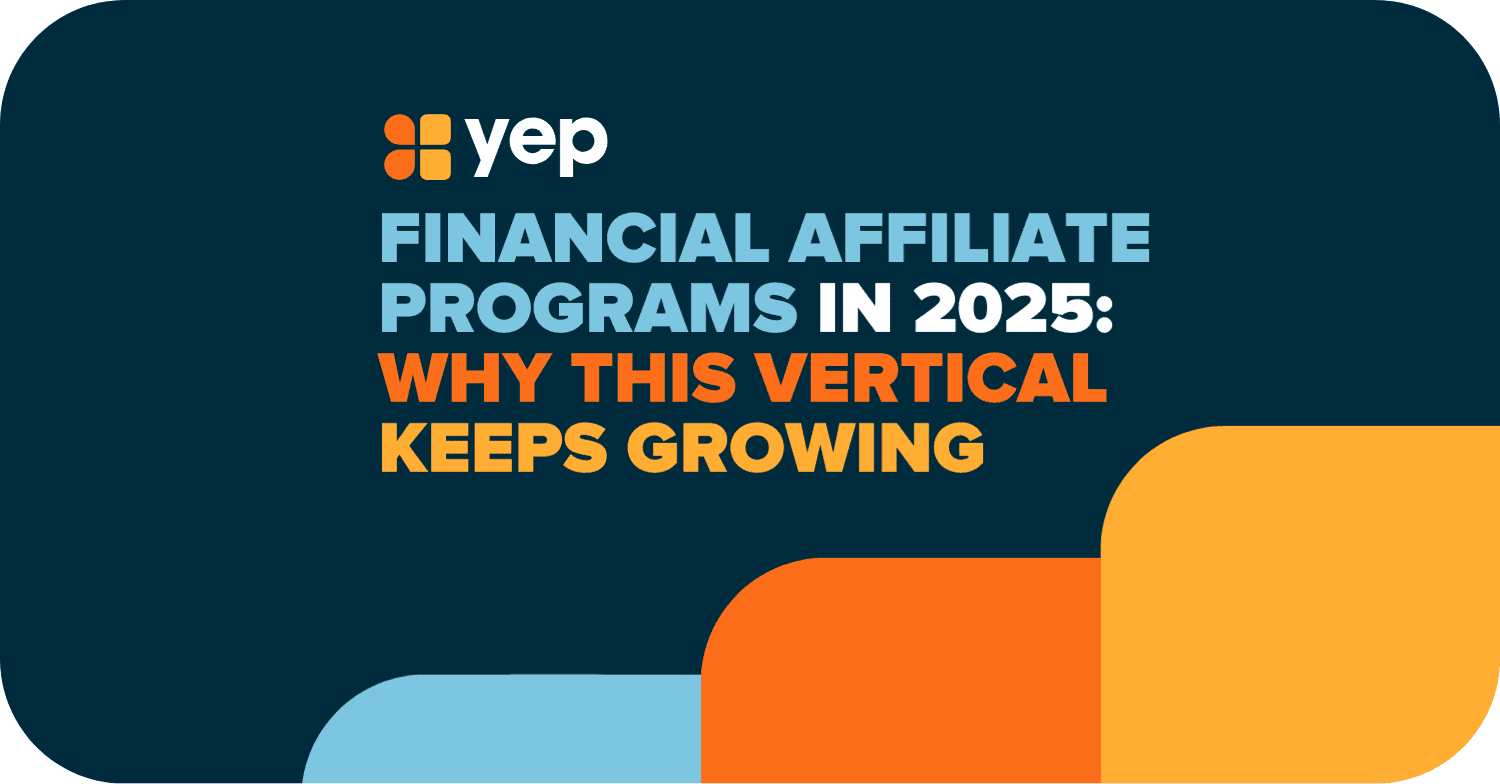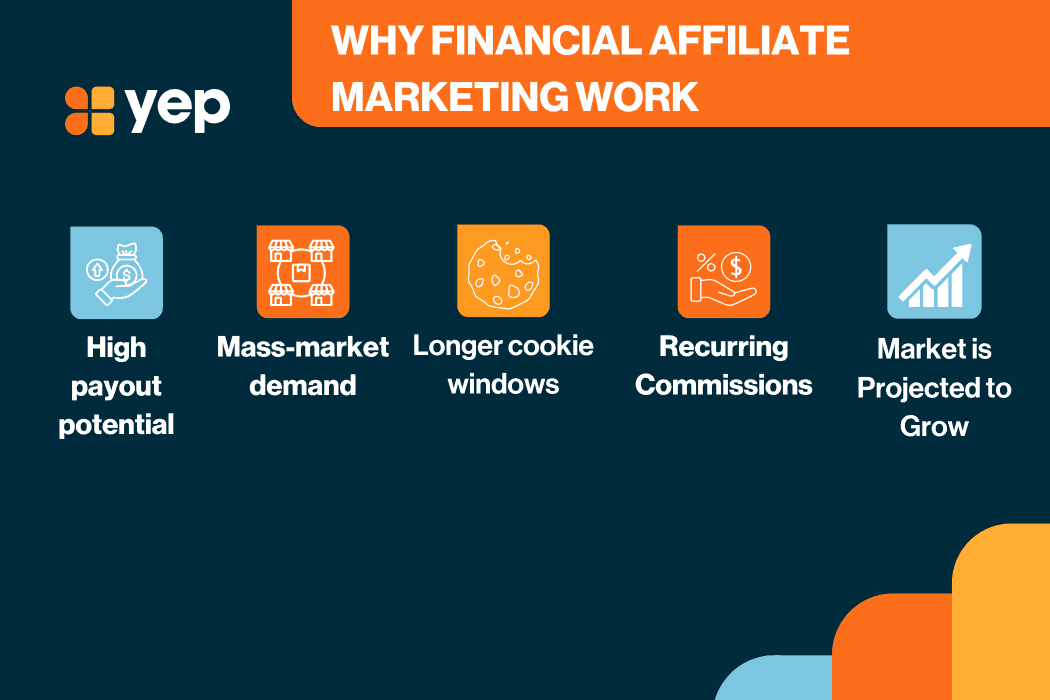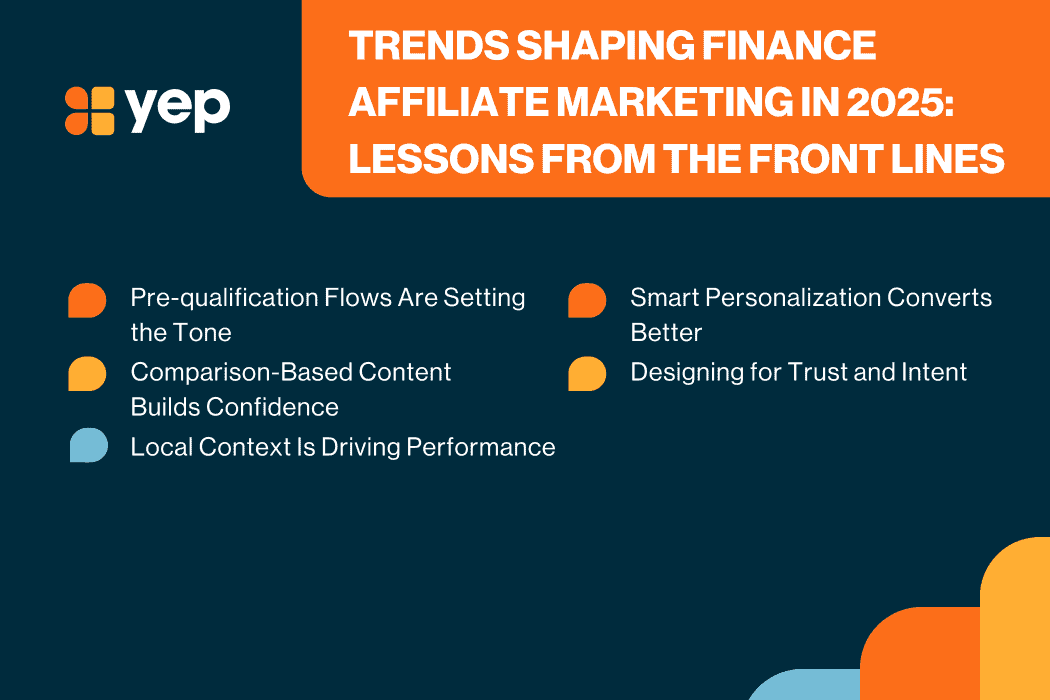
Financial Affiliate Programs in 2026: Why This Vertical Keeps Growing
If you’ve been in affiliate marketing for a while, you’ve probably noticed one vertical that never seems to slow down: finance.
Credit cards, loans, investing apps, banking products, they’re everywhere. Unlike some seasonal or trend-based niches, financial affiliate offers are available year-round and pay some of the highest commissions in the industry.
In 2026, the financial services vertical is worth your attention, whether you’re a publisher, creator, or brand looking to scale. Here’s what makes it so powerful (and how to get started).
Table of Contents
- Why Financial Affiliate Marketing Works
- The Unique Appeal of Finance Offers
- Subscription and Recurring Revenue Models
- Making Affiliate a Core Channel for Banks and Insurers
- Building Long-Term Partnerships with Affiliates
- Trends Shaping Finance Affiliate Marketing in 2026
- How to Succeed in the Finance Vertical
- Final Thoughts
Key Takeaways
- The finance vertical remains one of the highest‑paying and most stable niches in affiliate marketing, with year‑round demand and strong lifetime customer value.
- Financial products require trust‑first marketing — audiences want transparency, clear comparisons, and expert guidance before making decisions.
- Subscription‑based fintech and recurring commission models create ongoing revenue streams and compounding earnings potential for affiliates.
- Banks, insurers, and financial institutions are increasingly making affiliate marketing a core acquisition channel, especially for high‑consideration products.
- Long‑term affiliate relationships drive better results when supported with exclusive promotions, regular communication, and rewards for performance.
Why Financial Affiliate Marketing Works
In simple terms, you promote a financial product, maybe a credit card, savings account, or trading platform, and get paid when someone signs up or applies.
Most of these offers run on CPA (Cost Per Action) or CPL (Cost Per Lead) models, meaning you’re rewarded for delivering qualified leads. If you like hard data, here’s what makes this vertical worth your attention:
- High payout potential – Commissions often range from $4 to over $100 per action, with some programs offering a revenue share of up to 50%.
- Mass-market demand – Everyone needs to manage money, save, invest, or borrow at some point, which makes the audience large and evergreen.
- Extended tracking opportunities – Longer cookie windows (30–90 days) are common, giving you more time to convert leads into sales.
- Many finance programs offer recurring commissions for subscription-based products like SaaS or trading platforms.
- The U.S. financial services market is projected to grow steadily at ~8–10% annually through 2029.

Image Source: Yep Ads Website
The Unique Appeal of Finance Offers
Unlike many affiliate niches, the finance vertical taps into essential, high-trust decisions. A new blender or hoodie is an impulse buy; opening an investment account is not.
That means:
- Your audience will research and compare options before acting.
- They expect trustworthy, transparent content.
- Once they commit, they often stick with the service for years, meaning the brand (and you) get more lifetime value.
This is exactly why the payouts are so competitive; brands know a single quality lead can generate thousands in customer lifetime value.
Subscription and Recurring Revenue Models
Some of the most lucrative opportunities in financial affiliate marketing come from subscription-based fintech services, such as trading platforms, budgeting tools, and credit monitoring services. Affiliates in these niches often receive recurring commissions, earning a percentage every month the referred customer stays subscribed.
This creates a compounding effect: the longer your referrals remain active, the more your income grows without additional marketing spend. High-performing affiliates also receive retention bonuses or increased commission tiers for long-term referrals.
Making Affiliate a Core Channel for Banks and Insurers
From our perspective as a performance marketing agency, affiliate marketing in the financial sector is no longer just a complementary tactic; it’s a core growth channel.
Banks, insurers, and other financial institutions are seeing measurable results by integrating affiliates directly into their acquisition strategy. This is especially true for high-consideration products such as small business loans, mortgage services, and long-term insurance policies. In these categories, targeted publishers and creators can do what traditional advertising often can’t—guide high-intent customers through an informed decision-making journey.
By partnering with affiliates, financial brands gain access to specialized audiences they might otherwise struggle to reach. And when those audiences encounter the offer through a trusted publisher, the brand halo effect kicks in, instantly boosting credibility and making prospects more comfortable engaging with the product.
Building Long-Term Partnerships with Affiliates
From our experience managing finance campaigns, we know that the most successful programs focus just as much on retention as they do on recruitment. Bringing affiliates on board is only the beginning; the real performance lift comes from building strong, lasting relationships.
That’s why the top financial affiliate programs we manage invest in:
- Exclusive promotions and seasonal campaigns that affiliates can run to stand out in the market.
- Consistent communication and actionable performance insights to help affiliates optimize.
- Recognition and rewards for top performers, whether through bonuses, tiered commissions, or exclusive access to premium offers.
When affiliates feel supported, informed, and rewarded, they become more than just partners; they become brand advocates. And in a vertical where trust drives conversion, that advocacy can be the difference between a campaign that’s good and one that’s exceptional.

Image Source: Yep Ads Website
Trends Shaping Finance Affiliate Marketing in 2026
The digital finance space continues to evolve rapidly. Users are not just browsing. They are researching, comparing, and evaluating their options with more intent and scrutiny than ever before.
For anyone building high-performing campaigns in finance, the funnel needs to reflect this mindset. The highest-performing funnels today are those that understand how users approach financial decisions. People want to feel confident they are making the right choice, and they want your experience to guide them toward it without feeling pushed.
Pre-qualification Flows Are Setting the Tone
One of the strongest drivers of engagement right now is the use of intelligent pre-qualification flows. These are short, digestible interactions that help frame the offer in a personal and approachable way. Whether through a short quiz or a set of yes-or-no questions, this method gives the user a sense of progress and purpose.
Comparison-Based Content Builds Confidence
Comparison pages are structured to answer real user questions. What is the best option for someone with a short credit history? What card works best for travel rewards? Which provider is the most flexible for people with fluctuating income? Instead of trying to be everything to everyone, the most effective content today is tailored to individual needs and framed around decision support.
Local Context Is Driving Performance
Whether someone is shopping for insurance, credit cards, or loans, the specifics of their province or region can heavily influence their decision-making process. The best-performing experiences are leaning into this by offering localized landing pages and messaging. When users feel like an offer speaks directly to their location, it naturally builds more trust and gets more engagement.
Smart Personalization Converts Better
While personalization is often discussed in terms of ad targeting, what matters more now is how the landing experience adapts to the user in real time. This means updating headlines based on quiz results, changing body copy depending on the user’s entry point, or offering different lead forms depending on the traffic source. These small changes signal that the brand understands who the user is and what they are looking for.
Designing for Trust and Intent
The most successful campaigns right now are built on clear, transparent design. That means avoiding clutter, using familiar UX patterns, and being upfront about what the user can expect. When every detail of the experience reinforces professionalism and clarity, it gives the user permission to move forward.
Success in finance right now is about building funnels that feel thoughtful and informed. It is about understanding how users approach financial decisions and giving them a journey that aligns with that process. Work with Yep Ads today to unlock exclusive finance offers and start scaling with full-funnel support built for performance.
How to Succeed in the Finance Vertical
To wrap it up, if you want to succeed here, the playbook is clear:
- Start with high-quality, trust-first content — build guides, comparisons, and explainers that help your audience make informed choices.
- Be transparent, disclose affiliate relationships (FTC, GDPR compliance), and explain why you recommend a product.
- Experiment with formats, mix blog posts with short-form video, infographics, and email sequences.
- Track everything, know which campaigns bring in the best leads, and double down.
- Stay updated, regulations, offers, and payout rates change often in finance, so keep your content fresh.
Final Thoughts
Financial affiliate marketing isn’t the easiest niche to break into, but the payoff can be huge if you get it right. The key is trust, relevance, and smart optimization.
In a vertical where one customer can mean hundreds (or thousands) in lifetime value, even small traffic wins can lead to big revenue.
If you’re ready to explore high-paying verticals like finance, start building content that solves problems, earns trust, and drives real action.
And if you need help finding offers, setting up tracking, or optimizing campaigns, the Yep Ads team can point you in the right direction.
FAQs About Financial Affiliate Programs in 2026
- What types of financial products work best for affiliate marketing in 2026?
Credit cards, personal loans, mortgage services, investment platforms, budgeting apps, and insurance products are some of the top-performing categories. These offers tend to have high payouts due to the lifetime value of each customer. - How much can affiliates earn from promoting financial services?
Earnings vary by product and program, but commissions often range from $4 to $100+ per qualified lead. Some subscription-based services also offer recurring revenue, allowing affiliates to earn monthly for as long as the referred customer stays active. - Is it harder to convert leads in the finance vertical compared to other niches?
Yes, financial decisions often require more research and trust-building than impulse purchases. However, with high-intent audiences and the right content strategy—such as comparison guides or pre-qualification tools—conversion rates can be very strong. - How can financial brands build long-term relationships with affiliates?
Successful programs invest in retention by offering exclusive promotions, regular performance feedback, and recognition for top performers. Strong relationships turn affiliates into loyal brand advocates, which is essential in trust-driven verticals like finance. - Are there compliance requirements for promoting financial affiliate offers?
Yes. Affiliates must follow regulations such as the FTC guidelines in the U.S. or the GDPR in the EU, ensuring transparent disclosures of affiliate relationships and accurate, non-misleading product claims. Non-compliance can lead to penalties for both the brand and the affiliate.
You Might Also Like:
- Retail Affiliate Programs in 2026: What Brands Need to Know
- What Is Affiliate Marketing? A 2026 Full Guide
- How To Make an Affiliate Website
